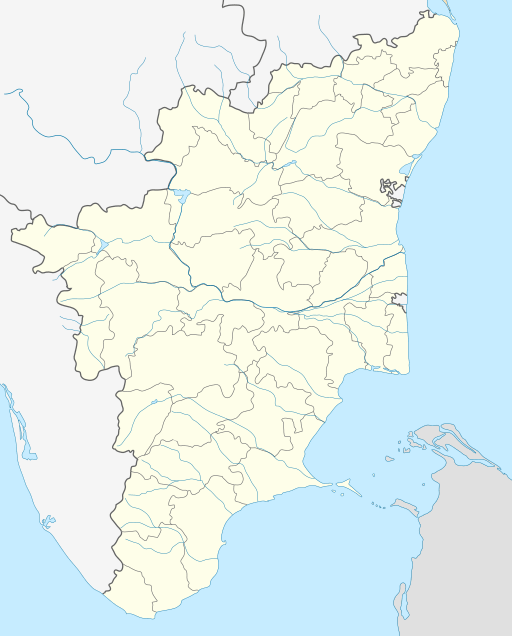Kailasanathar Temple, Thingalur
The Chandiranaar Temple (also called Kailasanathar temple or Thingalur temple) is a Hindu temple in the village of Thingalur, 33 kilometres (21 mi) from Kumbakonam on the Kumbakonam - Thiruvayyar road. The presiding deity is Soma (moon). However, the main idol in the temple is that of "Kailasanathar" or Shiva. The temple is considered one of the nine Navagraha temples in Tamil Nadu.
| Chandiranaar Temple | |
|---|---|
| Religion | |
| Affiliation | Hinduism |
| District | Thanjavur |
| Deity | Kailasanathar(Shiva) |
| Location | |
| Location | Thingalur |
| State | Tamil Nadu |
| Country | |
 Location in Tamil Nadu | |
| Geographic coordinates | 10°53′12″N 79°7′32″E |
| Architecture | |
| Type | Dravidian architecture |
Mahasivarathri, Margazhi Thiruvadirai, Panguni Uthiram and Thirukartigai are the major festivals celebrated in the temple. The temple is famous for first feeding of rice to infant children.
Legend
Legend has it that there lived a merchant Appoodi Adikal, a nayanar in the village of Thingalur who was a devotee of Shiva. Appoodi Adikal held Thirunavukkarasar in high regards. He had many establishments in the village named after Thirunavukkarasar. One day, Appar (Thirunavukkarasar) arrived at Thingalur and was surprised to see so many establishments in his name. Apoodi Adigal was fascinated to meet his idol in person and launched a grand feast. He sent his son to pick plaintain leaves who was killed by a venomous snake bite while the saint was being hosted. Appar, moved by Appoodi Adikal's devotion is said to have miraculously restored the lad to life.[1] During the Tamil month of Purattasi (Sep - Oct) and Panguni (March - April), moon light falls directly on the image of the presiding deity.[2] As per another legend, Chandra (moon), the handsome looking deity, married 28 daughters of Dakkan. He showed preference only to the last one among them, which infuriated the others. They all complained it to Dakkan, who cursed moon to lose all his powers. Chandra is believed to have worshiped Kailasanathar at this place and was restored all his powers.[3]
Architecture
The temple has a five-tier rajagopuram surrounded by two prakaram, closed precincts of the temple. The place is revered by the verses of Appar, but since there is no mention about the deity, it is not classified as Padal petra stalam. The image of Chandra is located in the second precinct and houses the image made of black granite and usually clad with white cloth.[3] The temple tank is named Chandrapushkarani.[4]
Navagraha
The temple is one of the nine Navagraha temples of Tamil Nadu and is a part of the popular Navagraha pilgrimage in the state - it houses the image of Chandra (Moon).[5] Kailasanathar Swamy temple is one of the nine Navagraha sthalas located in the Cauvery Delta region dedicated to planet Moon, called Thingal in Tamil language. There is a separate shrine for Lord Moon.[6]
Worship and festivals
The temple priests perform the pooja (rituals) during festivals and on a daily basis. Like other Shiva temples of Tamil Nadu, the priests belong to the Shaivaite community, a Brahmin sub-caste. The temple rituals are performed six times a day; Ushathkalam at 5:30 a.m., Kalasanthi at 8:00 a.m., Uchikalam at 10:00 a.m., Sayarakshai at 6:00 p.m., Irandamkalam at 8:00 p.m. and Ardha Jamam at 10:00 p.m. Each ritual comprises four steps: abhisheka (sacred bath), alangaram (decoration), neivethanam (food offering) and deepa aradanai (waving of lamps) for Surya, Usha and Chhaya. The worship is held amidst music with nagaswaram (pipe instrument) and tavil (percussion instrument), religious instructions in the Vedas read by priests and prostration by worshippers in front of the temple mast. There are weekly rituals like somavaram and sukravaram, fortnightly rituals like pradosham and monthly festivals like amavasai (new moon day), kiruthigai, pournami (full moon day) and sathurthi. Mahasivarathri, Margazhi Thiruvadirai, Panguni Uthiram and Thirukartigai are the major festivals celebrated in the temple. The temple is famous for first feeding of rice to infant children.[4]
Notes
- Thondaman, R. Vijayakumar (5 May 2006). "An exploration on foot". Friday Review. The Hindu. Retrieved 25 November 2018.
- V., Meena (1974). Temples in South India (1st ed.). Kanniyakumari: Harikumar Arts. p. 30.
- Anantharaman, Ambjuam (2006). Temples of South India (second ed.). East West. pp. 43–47. ISBN 978-81-88661-42-8.
- "Sri Kailasanathar temple". Dinamalar. 2011. Retrieved 13 September 2015.
- Suriya (2015). Jothirlingam: The Indian Temple Guide. Partridge Publishing. p. 92. ISBN 9781482847864.
- "Navagraha temples". Thanjavur District Administration. Archived from the original on 12 November 2013. Retrieved 7 July 2013.
References
- Sanjay Singh (2009). Yatra2Yatra. Yatra2Yatra. p. 251.
- Tourist Guide to Tamil Nadu. Sura Books. pp. 85–86. ISBN 81-7478-177-3, ISBN 978-81-7478-177-2.